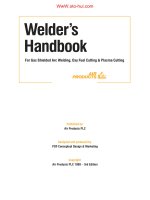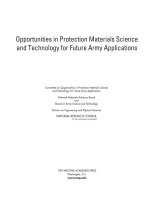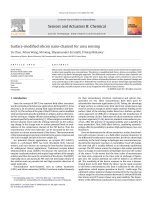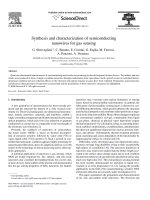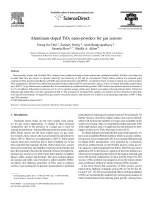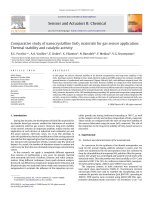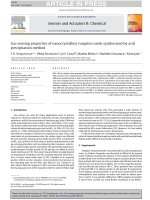- Trang chủ >>
- Khoa Học Tự Nhiên >>
- Vật lý
nanosize hexagonal tungsten oxide for gas sensing applications
Bạn đang xem bản rút gọn của tài liệu. Xem và tải ngay bản đầy đủ của tài liệu tại đây (924.76 KB, 5 trang )
A
vailable online at www.sciencedirect.com
Journal of the European Ceramic Society 28 (2008) 913–917
Nanosize hexagonal tungsten oxide for gas sensing applications
Csaba Bal
´
azsi
a,∗
, Lisheng Wang
b
, Esra Ozkan Zayim
c
, Imre Mikl
´
os Szil
´
agyi
d
,
Katar
´
ına Sedlackov
´
a
e
, Judit Pfeifer
a
, Attila L. T
´
oth
a
, Pelagia-Irene Gouma
b
a
Ceramics and Composites Laboratory, Research Institute for Technical Physics and Materials Science, Hungarian Academy of Sciences,
Konkoly-Thege ´ut 29-33, H-1121 Budapest XII., Hungary
b
Department of Materials Science and Engineering, 314 Old Engineering Building, SUNY, Stony Brook, NY 11794-2275, USA
c
Department of Physics, Faculty of Science and Letters, Istanbul Technical University, Maslak, Istanbul 80626, Turkey
d
Deparment of Inorganic and Analytical Chemistry, Budapest University of Technology and Economics, H-1111 Budapest, Szt. Gell´ert t´er 4, Hungary
e
Thin Film Physics Laboratory, Research Institute for Technical Physics and Materials Science, Hungarian Academy of Sciences,
Konkoly-Thege ´ut 29-33, H-1121 Budapest, Hungary
Available online 10 October 2007
Abstract
Tungsten oxides and tungsten oxide hydrates are among the most used materials in electro-, photo- and gaso-chromic applications. Lately, tungsten
oxides have been commonly applied as sensing layers for hazardous gas detection as well. In this work, a soft chemical nanocrystalline processing
route has been demonstrated for the preparation of hexagonal tungsten oxides. The acidic precipitation was followed by hydrothermal and heat
treatments at low temperatures. The morphology of parent phases, such as amorphous WO
3
·2H
2
O, orthorhombic WO
3
·1/3H
2
O, and resulting oxides
with open structured nanosized hexagonal platelets of h-WO
3
particles have been studied by scanning electron microscopy (SEM), by conventional
transmission electron microscopy (TEM) and by high resolution transmission electron microscopy (HRTEM). Structural and electrochemical
performance of thin films have been determined by atomic force microscopy and cyclic voltammetry. The ion insertion properties of tungsten oxide
hydrate and tungsten oxide films show a clear dependence on the presence of structural water and on the close packed structure. Sensing properties
of the prepared tungsten oxides have been tested with respect to ammonia gas.
© 2007 Elsevier Ltd. All rights reserved.
Keywords: Soft chemical synthesis; Transition metal oxides; Nanocomposites; Sensors; Functional application
1. Introduction
Metal oxides are polymorphic compounds and controlled
chemical processing may stabilize oxide polymorphs that would
otherwise be energetically unstable. Recent studies by the
authors’ group
1–3
led to the hypothesis that the ability for selec-
tive detection of a particular gaseous analyte in the presence
of interfering gas mixtures (i.e. sensor selectivity) is largely
determined by the chosen crystalline polymorph (specific crys-
tallographic phase) of a stoichiometric and pure metal oxide used
for sensing. Transition metal oxide such as MoO
3
and WO
3
were
∗
Corresponding author at: Ceramics and Composites Laboratory, Hungarian
Academy of Sciences, Research Institute for Technical Physics and Materials
Science, H-1525 Budapest, P.O. Box 49, Hungary. Tel.: +36 1 392 2249;
fax: +36 1 392 2226.
E-mail address: (C. Bal
´
azsi).
URLs: (C. Bal
´
azsi),
(C. Bal
´
azsi).
used as model systems in those studies. Orthorhombic (␣-phase)
MoO
3
was found to exhibit high specificity to the detection of
ammonia and amines. Issues of structural stability due to the
high volatility of this material, however, limit its use in high-
temperature sensing applications. The search for alternative
materials that are isostructural with MoO
3
identified tungsten
oxides as promising candidates. It seems that “loosely-bound”
open structures are necessary in order to achieve selective amine
detection, as they enable the reaction of lattice oxygen with the
gas and provide easy mechanisms for accommodating the off-
stoichiometric metal: O ratio. The layered structure tungsten
oxide dihydrate (H
2
WO
4
·H
2
O) and the open structure hexag-
onal form of WO
3
seem to be good candidates for the use of
reaction-based, and adsorption (chemisorption)-based sensing
applications. Several decades earlier H
2
WO
4
·H
2
O was suc-
cessfully applied as the parent phase for metastable hexagonal
tungsten oxide representing an optimal substance in intercala-
tion chemistry. For the preparation of H
2
WO
4
·H
2
O, two main
routes
4,5
are known. The main difference between these two
0955-2219/$ – see front matter © 2007 Elsevier Ltd. All rights reserved.
doi:10.1016/j.jeurceramsoc.2007.09.001
914 C. Bal´azsi et al. / Journal of the European Ceramic Society 28 (2008) 913–917
methods is in the rate of precipitation caused by differing pH in
the reaction solutions. The morphology and structural stability
of precipitated grains is directly controlled by precipitation and
precipitate washing conditions.
6–9
In the present study acidic
precipitation is carried out by a nanocrystalline processing route;
the preparation of nanocrystalline hexagonal WO
3
is demon-
strated in a powder bed and in a thin layer over a silicon wafer
deposited from a precursor suspension in situ with the purpose
to integrate sensing layers into silicon chip technology. Electro-
chemical and sensing properties of the prepared tungsten oxides
are tested under normal testing conditions.
2. Experimental details
2.1. Sample preparation
H
2
WO
4
·H
2
O samples were prepared by acidic
precipitation
4–6
from sodium tungstate solution. The prepara-
tion method of Zocher combining washing and centrifuging
the precipitated gel was modified.
10
An overnight cooling
of the freshly precipitated gel was applied before washing
of the gel. The resulted gels were washed and centrifuged
3–5 times depending on the process. Suspensions of the
washed gels were passed to hydrothermal dehydration. The
hydrothermal reaction was carried out in Parr acid digestion
bombs at autogenous pressure at 125 ± 5
◦
C. Products after
hydrothermal dehydration were dried at room temperature or
used as received suspensions. Droplet(s) of the as received
suspension were deposited onto ITO conductive transparent
glass and (1 1 0) oriented silicon wafers. The silicon wafer
covered with the deposit and the resulted powder was then
passed to final dehydration (330–340
◦
C furnace temperature,
90 min annealing time, ambient air).
2.2. Measurements
Structural characterization was conducted using X-ray
diffraction (Bruker AXS D8 Discover X-ray diffractometer with
Cu K␣ radiation) and in situ high-temperature X-ray diffraction
(HT-XRD), PANalytical X’pert Pro MPD X-ray diffractometer
equipped with an Anton Paar HTK-2000 high-temperature XRD
camera using Cu K␣ radiation. HT-XRD experiments were per-
formed in static air using a 10
◦
C min
−1
heating rate between
XRD measurements.
The morphology of the samples was studied by scan-
ning electron microscopy (LEO 1540XB field emission SEM).
The structure of samples was investigated further by conven-
tional transmission electron microscopy (TEM) using a Philips
CM-20 microscope and by high-resolution transmission elec-
tron microscopy (HRTEM) with a JEOL 3010 microscope.
AFM measurements of WO
3
·1/3H
2
O layers deposited onto
5 m × 5 m Corning glass (2947) substrates were also carried
out.
Electrochemical properties of tungsten oxide hydrate thin
films were studied by cyclic voltammetry.
11
The WO
3
·1/3H
2
O
films were prepared directly from suspensions (received from
the hydrothermal process) on ITO conductive transparent glass
Fig. 1. XRD patterns of Zocher type tungstic acid hydrate gel and its dehydration
derivatives. Sample “a” identified as WO
3
·1/3H
2
O, (JCPDS card 35–270) and
sample “b” identified as h-WO
3
(JCPDS card 33–1387).
substrates. The substrates were consecutively rinsed with ace-
tone, methanol and isopropyl alcohol and dried in air. The spin
coating speed was set at 2000 rpm.
Sensing layers have been produced by spin coating 10 mg
powder/5 ml n-butanol suspensions on Al
2
O
3
substrates with
Au-metallization. Sensing tests were carried out in the gas flow
bench set-up at SUNY, Stony Brook.
12
The gases used in the
sensing setup were UHP nitrogen (Praxair), UHP oxygen (Prax-
air), 1000 ppm ammonia in nitrogen (BOC gases). Concentration
of ammonia was varied by varying its flow rate in conjunction
with nitrogen flow rates. The gases were controlled through 1479
MKS Mass flow controllers whose channels were connected to
a Type 247-MKS 4-channel readout which is calibrated to read
the flow rate of the gases directly in sccm. The combined flow
rate of the gases was maintained at 1000 sccm. The gas mix-
ture is passed through a tube furnace (Lindberg/Blue), which
Fig. 2. XRD patterns of tungsten oxide layers deposited on 100 Si wafer. Sample
“WO
3
·1/3H
2
O” (JCPDS card 35–270) was formed by depositing a droplet of
suspension on Si and then dried at RT, under air. Sample “h-WO
3
” (JCPDS card
33–1387), the preceding sample heat-treated at 330
◦
/90 min, under air.
C. Bal´azsi et al. / Journal of the European Ceramic Society 28 (2008) 913–917 915
Fig. 3. Tungstic acid hydrate mother phase gel precipitated according to the
modified Zocher process.
can be heated at a programmed rate. The sensing element is
placed inside the tube furnace with quartz tube (2.5 cm diame-
ter, 60 cm length) and is electrically connected to outsides leads
using gold wires. Sensing experiments were carried out at room
temperature and at various temperatures up to 300
◦
C. Electrical
resistance measurements
1,2
of the sensing films as a function of
the gas concentration were carried out using an Agilent 34401
digital multimeter.
3. Results
Figs. 1 and 2 show XRD patterns of the samples derived
from the Zocher type tungstic acid gel. Sample “1a” is the pow-
der product after hydrothermal dehydration and sample “1b” is
the powder product after dehydration under air of sample “a”.
XRD patterns were compared and checked with the Joint Com-
mittee on Powder Diffraction Standards files. Sample “1a” was
identified as WO
3
·1/3H
2
O, (JCPDS card 35–270) and sample
“1b” was identified as h-WO
3
(JCPDS card 33–1387). Simi-
Fig. 4. AFM images of WO
3
·1/3H
2
O nanocrystalline film after two washing
processes.
Fig. 5. SEM image of h-WO
3
derivative gained from the precursor shown in
Fig. 3.
larly Zocher type tungstic acid derivatives deposited on (1 0 0)
Si wafer are shown in Fig. 2. The sample “WO
3
·1/3H
2
O” is
formed by drying (room temperature, under air) a droplet of
suspension on the Si wafer; sample “h-WO
3
” is the dehydra-
tion product of sample “WO
3
·1/3H
2
O” at 330
◦
/90 min under
air. Comparing the patterns it is clear, that the dehydration pro-
cess of WO
3
·1/3H
2
OtohWO
3
is undisturbed even in layers on
top of Si wafer.
In Fig. 3 tungstic acid hydrate gel, the mother phase of the
nanosize dimension derivatives applied for sensing layers is
shown. This morphology seems to be promising as a precursor
for sensing layers with nanosize dimension grains. AFM images
in Fig. 4 show WO
3
·1/3H
2
O films derived from the mother phase
shown in Fig. 3. The grain size is uniform with grains packed
together to form a nanocrystalline film.
Fig. 5 shows hexagonal WO
3
prepared by hydrothermal and
air ambient dehydration processes from the mother phase. The
crystalline derivative consists of aggregates (1–2 m) of rods
and platelets with thickness of ∼20–30 nm.
Fig. 6. Plan view TEM image of WO
3
·1/3H
2
O film.
916 C. Bal´azsi et al. / Journal of the European Ceramic Society 28 (2008) 913–917
Fig. 7. Plan view TEM image of h-WO
3
film after annealing.
Fig. 8. Cyclic voltammetry of WO
3
·1/3H
2
O film derived from a 2× washed
precursor gel with respect to various scan rates, in 1 M LiClO
4
/PC.
Fig. 9. Sensing responses of h-WO
3
to various levels of NH
3
doses at 300
◦
C.
Fig. 10. Sensitivity of h-WO
3
sensor to NH
3
as a function of concentration.
Carrying out TEM and HRTEM investigations (see
Figs. 6 and 7) we found the correlation between structure
and other properties of WO
3
films. The average size of
crystallites after hydrothermal treatment is ∼50–100 nm and
the electron diffraction showed the orthorhombic phase of
WO
3
·1/3H
2
O crystallites. After 330
◦
C air ambient treatment
of the powder, the average size of WO
3
crystallites decreased
to ∼30–50 nm. Electron diffraction confirmed the phase change
from orthorhombic to hexagonal one.
Fig. 11. In situ HT-XRD patterns of h-WO
3
in static air.
C. Bal´azsi et al. / Journal of the European Ceramic Society 28 (2008) 913–917 917
Cyclic voltammograms of samples with crystalline
WO
3
·1/3H
2
O films derived from a 2× washed precursor gel
are given in Fig. 8. While no anodic peaks are observed, there
is a well-defined cathodic peak, indicating the quick process
for lithium insertion, even at very low voltages.
The plots in Fig. 9 show the response of the sensing layer
prepared from h-WO
3
to ammonia at various levels of ammo-
nia in one dose. The measurement was carried out at 300
◦
C.
The films showed a decrease in resistance on exposure to NH
3
,
which is characteristic to an n-type semiconductor. The lay-
ers were found to be sensitive in the concentration range of
50–500 ppm and the sensing response was found to change lin-
early with ammonia concentration (Fig. 10). The sensitivity at
lower temperature was not satisfactory; the sensitivity at higher
temperature seems to be promising. In situ HT-XRD patterns of
h-WO
3
in static air (Fig. 11) showed that h-WO
3
was stable up to
425
◦
C.
4. Conclusion
In this paper we report on the acidic precipitation route for
preparation of nanosize WO
3
·1/3H
2
O and h-WO
3
powders and
suspensions. The electrochemical and gas sensing properties of
layers based of nanopowders have been studied. The layers were
electrochemically active and sensitive to NH
3
.
Acknowledgements
The work was supported by the bilateral NSF-OTKA-MTA
co-operation, contract no. MTA:96 OTKA: 049953 and also by
a GVOP-3.2.1 2004-04-0224/3.0 grant.
References
1. Prasad, A. K., Kubinski, D. and Gouma, P. I., Comparison of sol–gel and
RF sputtered MoO3 thin film gas sensors for selective ammonia detection.
Sens. Actuators, 2003, B9, 25–30.
2. Prasad, A. K., Gouma, P. I., Kubinksi, D. J., Visser, J. H., Soltis, R. E. and
Schmitz, P. J., Reactively sputtered MoO
3
films for ammonia sensing. Thin
Solid Films, 2003, 436, 46–51.
3. Gouma, P. I., Nanostructured polymorphic oxides for advanced chemosen-
sors. Rev. Adv. Mater. Sci., 2003, 5, 123–138.
4. Zocher, H. and Jacobson, K.,
¨
Uber Taktosole. Kolloidchem. Beih., 1929, 28,
167–205.
5. Freedman, M. L., The tungstic acids. J Am. Chem. Soc., 1959, 81,
3834–3839.
6. Gerand, B., Nowogrocki, G. and Figlarz, M., A new tungsten trioxide
hydrate, WO
3
·1/3H
2
O: preparation, characterization, and crystallographic
study. J. Solid State Chem., 1981, 38, 312–320.
7. Gerand, B., Nowogrocki, G., Guenot, J. and Figlarz, M., Structural study of
a new hexagonal form of tungsten trioxide. M., J. Solid State Chem., 1979,
29, 429–434.
8. Pfeifer, J., Cao, G., Tekula-Buxbaum, P., Kiss, B. A., Farkas-Jahnke, M. and
Vadasdi, K., A reinvestigation of the preparation of tungsten oxide hydrate
WO
3
·1/3H
2
O. J. Solid State Chem., 1995, 119, 90–97.
9. Bal
´
azsi, Cs. and Pfeifer, J., Development of tungsten oxyde hydrate phases
during precipitation, room temperature ripening and hydrothermal treat-
ment. Solid State Ionics, 2002, 151, 353–358.
10. Bal
´
azsi, Cs., Prasad, A. K., Pfeifer, J., T
´
oth, A. L. and Gouma, P. I.,
Wet chemical synthesis of nanosize tungsten oxide for sensing applica-
tions. In Proceedings of the First International Workshop on Semiconductor
Nanocrystals, SEMINANO 2005, Vol. 1: Materials and Preparation, ed. B.
P
˝
od
¨
or, Zs. J. Horv
´
ath and P. Basa, 2005, pp. 79–83.
11. Ozkan, E., Lee, S Liu, H.P., Tracy, C.E., Tepehan, F.Z., Pitts, J.R. and Deb,
S.K., Electrochromic and optical properties of mesoporous tungsten oxide
films, Solid State Ionics, 2002, 149, 139–146.
12. Prasad, A.K., Study of gas specificity in MoO
3
/WO
3
thin film sensors and
their arrays, PhD Dissertation, Stony Brook University, Stony Brook NY,
USA, May 2005.
